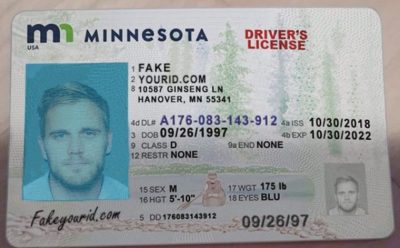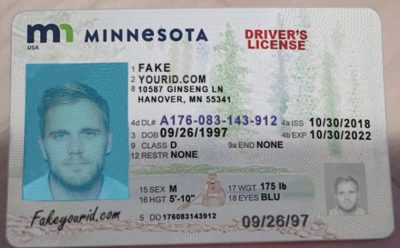Introduction
In an era where authenticity and integrity are highly valued, educational institutions often face the challenge of verifying the documents presented by students. One such document that may sometimes be forged is the driver’s license. A driver’s license can serve as a form of identification for various purposes within an educational setting, such as for campus – related activities or for certain course – related requirements. It is crucial for educational institutions to have reliable methods to check for fake driver’s licenses to maintain the security and integrity of their operations.
Visual Inspection
The first step in the verification process is often a visual inspection. Educational institution staff trained in document verification will closely examine the physical appearance of the driver’s license. They will look at the overall quality of the material. Genuine driver’s licenses are typically made from high – quality plastic with a specific thickness and texture. Fake licenses may be made from lower – quality materials that feel flimsy or have an unusual texture.
Another aspect of visual inspection is looking at the printing quality. The text on a real driver’s license is sharp, clear, and evenly printed. The colors are vibrant and consistent. In contrast, fake licenses may have blurry text, uneven printing, or colors that seem off. Additionally, the photos on real driver’s licenses are of high quality, with a clear and natural – looking image of the license holder. Fake licenses may have pixelated or low – resolution photos, or the photo may not match the overall quality of the document.

Security features are also a key part of visual inspection. Most modern driver’s licenses have a variety of security features such as holograms, watermarks, and microprinting. Holograms are three – dimensional images that are difficult to replicate. They may be present on the front or back of the license and can display different images or patterns when viewed from different angles. Watermarks are faint images or text that are embedded within the plastic of the license and can only be seen when the license is held up to the light. Microprinting involves very small text that is almost invisible to the naked eye but can be magnified for verification. If any of these security features are missing, damaged, or appear to be poorly replicated, it could be a sign of a fake license.
Verification with the Issuing Authority
In addition to visual inspection, educational institutions can contact the issuing authority of the driver’s license. Each driver’s license is issued by a specific government agency, such as a department of motor vehicles (DMV) in the relevant jurisdiction. Educational institutions can reach out to the DMV either through official channels such as phone, email, or an online verification system if available.
When contacting the issuing authority, the institution will provide details from the driver’s license, such as the license number, the name of the license holder, and the date of issue. The DMV will then check its records to confirm whether the license is valid and whether the details match what is on file. This method is highly reliable as the DMV has access to the official database of all issued driver’s licenses and can provide accurate information about the license’s authenticity. However, it may take some time to receive a response, especially if the DMV is experiencing high volumes of inquiries or if the process involves multiple steps of verification.
Cross – Referencing with Other Documents
Educational institutions can also cross – reference the driver’s license with other documents provided by the student. For example, they can compare the name, date of birth, and address on the driver’s license with the information on the student’s passport, birth certificate, or other official identification documents. If there are discrepancies in the information, it could be a red flag for a fake driver’s license.
Furthermore, if the student has provided academic transcripts or other educational – related documents, the institution can check if the name and other identifying details match. In some cases, a fake driver’s license may be used in conjunction with other forged documents, and cross – referencing can help uncover such discrepancies. This method requires careful attention to detail and the availability of multiple reliable documents for comparison.
Technology – Based Verification
With the advancement of technology, there are now various tools available to help educational institutions verify driver’s licenses. Some institutions use document scanners that are equipped with software capable of analyzing the physical characteristics of the license. These scanners can detect the presence of security features, analyze the printing quality, and even compare the license against a database of known genuine licenses.
There are also mobile applications and online platforms that can be used for quick verification. These tools may use image recognition technology to scan the driver’s license and extract key information. They can then cross – reference this information with official databases or perform other checks to determine the license’s authenticity. However, it is important to ensure that these technology – based solutions are reliable and have access to accurate and up – to – date information.
Training of Staff
Educational institutions need to invest in training their staff on how to check for fake driver’s licenses. Staff members who are likely to come into contact with driver’s licenses, such as admissions officers, student services personnel, and security guards, should receive comprehensive training on document verification. This training should cover the different aspects of visual inspection, including how to identify security features, as well as how to use technology – based verification tools.
Training should also include information on the procedures for contacting the issuing authority and cross – referencing with other documents. By having well – trained staff, educational institutions can increase their ability to detect fake driver’s licenses and maintain the security and integrity of their student population.
Common Problems and Solutions
- Problem: Inconsistent Training – Some staff members may not receive sufficient or consistent training on driver’s license verification. This can lead to inconsistent verification processes and a higher chance of missing fake licenses. Solution: Establish a standardized training program for all relevant staff. Provide regular refresher courses to keep their skills up – to – date. Have a system in place to track who has received training and ensure that all new staff members are trained promptly.
- Problem: Difficulty in Contacting the Issuing Authority – The issuing authority, such as the DMV, may be unresponsive, have long wait times, or the verification process may be complex. Solution: Research and establish clear and reliable communication channels with the DMV. Build relationships with the DMV representatives if possible. Consider using online verification systems if available to speed up the process. If there are long wait times, set up a system to follow – up on verification requests.
- Problem: False Positives with Technology – Based Tools – Technology – based verification tools may sometimes flag a genuine license as fake due to image quality issues, database inaccuracies, or other technical glitches. Solution: Regularly update the software and databases used by the technology – based tools. Have a secondary verification process in place, such as visual inspection or cross – referencing with other documents, when a false positive is suspected. Provide feedback to the tool developers if there are recurring false – positive issues.
- Problem: Lack of Access to Multiple Documents for Cross – Referencing – Sometimes, students may not provide all the necessary documents for cross – referencing, or the institution may not have the authority to access certain documents. Solution: Clearly communicate to students the importance of providing all relevant identification and supporting documents. If access to certain documents is restricted, explore alternative verification methods, such as more in – depth visual inspection or additional communication with the student to clarify information.
- Problem: Advanced Forgery Techniques – Forgers may use more advanced techniques to create fake driver’s licenses that are difficult to detect through traditional methods. Solution: Stay updated on the latest forgery trends and techniques. Continuously invest in new verification technologies and training for staff. Collaborate with law enforcement agencies or other institutions that may have more information on emerging forgery threats.
Fake ID Pricing
unit price: $109
| Order Quantity | Price Per Card |
|---|---|
| 2-3 | $89 |
| 4-9 | $69 |
| 10+ | $66 |



